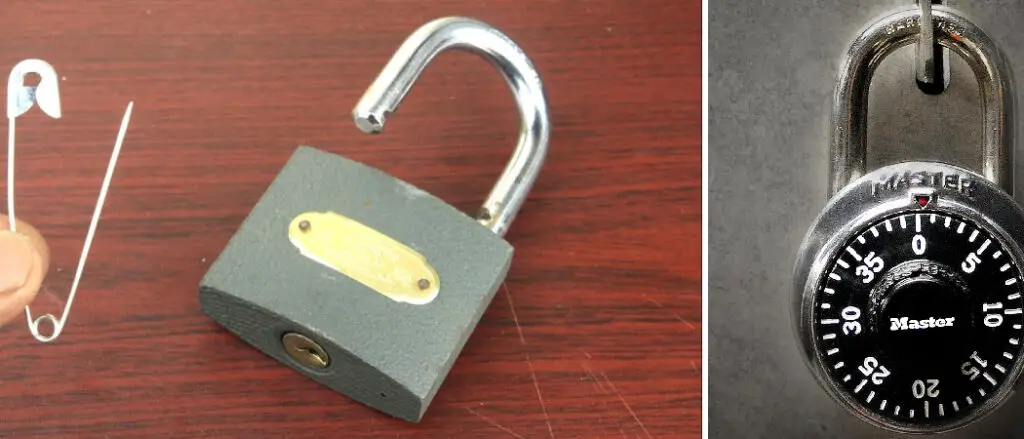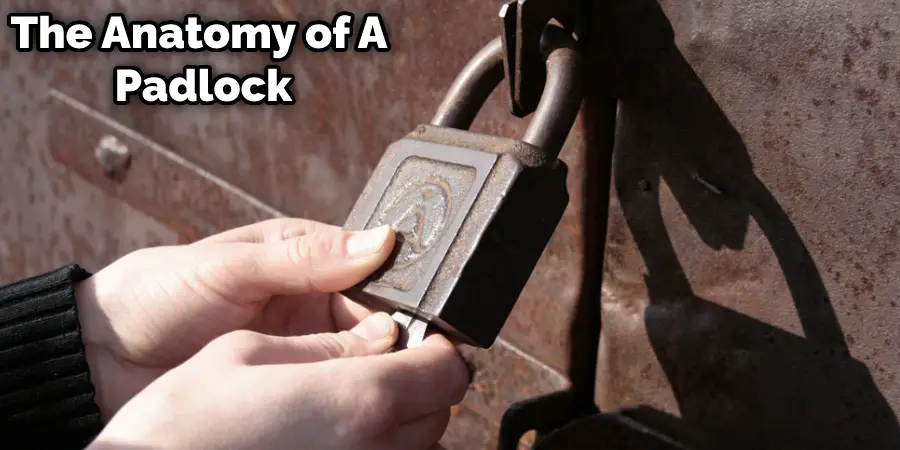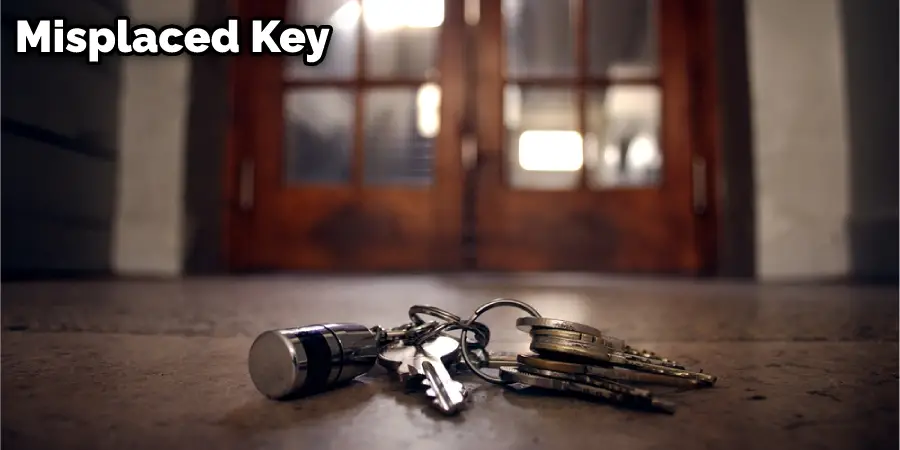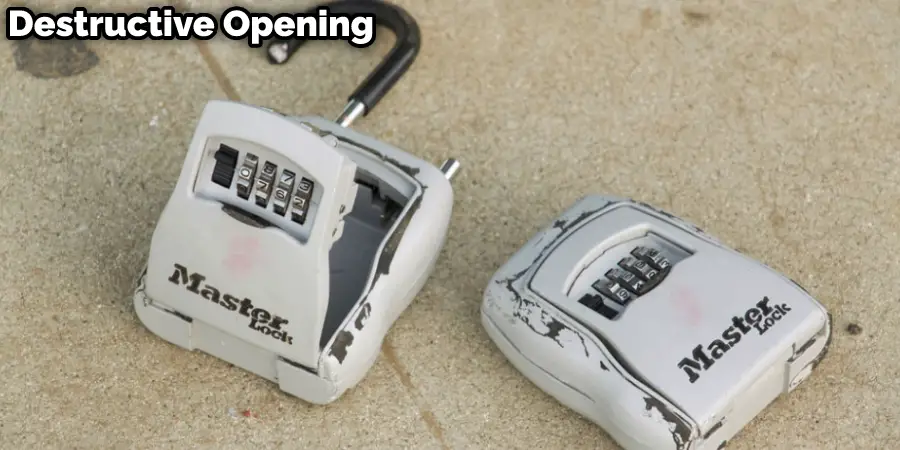Locked out of your home, office, or storage unit? There’s no need to worry. Instead of resorting to breaking the lock open, there is a much easier and more secure way to access what you are looking for and understand how to unlock a padlock without physical damage. Whether it’s unlocking a bike chain lock or another type of portability security measure, this helpful guide will teach you all the tips and tricks so that you can break in with ease!

From preventing potential damage through shim techniques, specialized tools, and force options – we’ll give you valuable insight into the world of picking padlocks so that you can gain access quickly and securely. So keep on reading to learn more about how to open a padlock without breaking it.
Understanding the Anatomy of A Padlock
To successfully open a padlock without damaging it, it’s crucial to have a good understanding of its anatomy. Here are the key components of a typical padlock:
- Shackle: The shackle is the U-shaped metal loop that engages with the locking mechanism. It is the part of the padlock that you aim to release to open it. The shackle can be made of hardened steel or other strong materials to resist cutting or sawing.
- Lock Body: The lock body is the main housing that contains the internal mechanisms of the padlock. It often consists of two parts that encase the core components. The lock body provides protection and support for the internals.
- Keyway: The keyway is the narrow opening or slot on the lock body where you insert the key. It allows the key to engage with the locking mechanism and manipulate the internal components to release the shackle. Keyways can vary in shape and size depending on the type and brand of the padlock.
- Lock Pins: Lock pins are the small metal components inside the lock body that interact with the key to secure or release the shackle. They are typically spring-loaded and come in pairs: driver pins and key pins. The driver pins rest in the shear line between the lock body and the shackle, while the key pins align with the specific cuts on the key.
- Springs: Springs are an integral part of a padlock’s mechanism. They apply pressure to the lock pins, keeping them in place and facilitating their movement when the correct key is inserted.
- Core or Cylinder: The core or cylinder is the central part of the lock body where the key is inserted. It houses the key pins and driver pins, allowing the key to properly interact with them.

Understanding the anatomy of a padlock enables you to visualize how its components work together and how they can be manipulated using non-destructive techniques such as lockpicking or shimming. By gaining this knowledge, you’ll be better equipped to approach the task of opening a padlock without causing any damage.
6 Reasons You Might Need to Open a Padlock without Breaking It
1. Misplaced Key:
One of the most common scenarios is when you misplace the key to a padlock. Instead of resorting to destructive methods, knowing how to open the padlock without breaking it can save you time, money, and the hassle of replacing the lock.

2. Forgotten Combination:
If you have a combination padlock and forget the code, knowing non-destructive methods to open it can be incredibly useful. It allows you to regain access without having to resort to damaging techniques or contacting the manufacturer.
3. Emergency Situations:
Imagine finding yourself in an emergency situation where you need quick access to a locked area secured by a padlock, such as a storage unit, cabinet, or gate. Being able to open the padlock without breaking it can provide immediate access and potentially save the day.
4. Maintenance and Repairs:
In cases where you need to perform maintenance or repairs on a padlock, opening it without damaging it allows you to access the internals, lubricate the mechanism, or replace worn components. This is especially important for padlocks used in high-security environments or critical applications.
5. Locksmithing Practice:
Learning how to open padlocks without breaking them is a valuable skill for aspiring locksmiths or hobbyists interested in lockpicking. It allows them to practice their techniques, understand different lock mechanisms, and gain expertise without causing permanent damage to the padlocks.
6. Authorized Access:
There may be situations where you have legal authorization to open a padlock but lack the key or combination. For instance, you may need to access a padlock securing a property you own, a storage unit with forgotten access details, or a lock that has malfunctioned. Opening the padlock without breaking it ensures authorized access while preserving the lock’s integrity.
In all these scenarios, knowing how to open a padlock without causing damage provides a valuable solution. It can save you time, money, and frustration, allowing you to regain access to locked areas or objects while preserving the functionality of the padlock.
8 Methods on How to Open a Padlock without Breaking It
1. Lockpicking:
Lockpicking is the practice of manipulating a lock’s components to open it without using its key or combination. It requires special tools and practice but can be an effective way of opening padlocks without causing any damage.
2. Shimming:
Shimming is another technique used to open padlocks without breaking them. It involves inserting a thin strip of metal between the lock’s body and shackle to create sufficient space for the shackle to be released.
3. Bumping:
Bumping is a non-destructive method of opening padlocks that has become increasingly popular in recent years. It only requires a special tool called a bump key and some practice to master the technique.
4. Knocking:
Knocking is another non-destructive way of opening padlocks that relies on tapping the lock’s components in a specific pattern. It takes some practice to get right but can be an effective method of opening padlocks without causing any damage.
5. Impressioning:
Impressioning is a technique used to create a working key for padlocks without the original key or combination. It requires special tools and practice but can effectively gain access without damaging the lock.
6. Decoding:
Decoding is a method used to open padlocks without breaking them by manipulating the lock’s components to determine their combination. It requires a special ” decoder ” tool and some practice to master the technique.
7. Magnetic Lockpicking:
Magnetic lockpicking is another non-destructive method of opening padlocks that uses magnets of varying strengths to manipulate the lock’s mechanism. It requires a special tool and practice, but it can effectively open padlocks without causing any damage.
8. Destructive Opening:
Finally, when you have no alternative, destructive opening techniques such as drilling or cutting can be used to open the padlock. However, these methods should only be used as a last resort as they can cause permanent damage to the lock.

6 Common Mistakes People Might Make when Opening a Padlock without Breaking It
1. Applying Too Much Pressure:
Applying too much pressure when using any of the unlocking techniques can cause damage to the padlock. It’s important to be gentle with all movements when opening a padlock without breaking it and use only enough force necessary to manipulate the lock’s components.
2. Not Using the Right Tools:
Using the wrong tools for opening a padlock without breaking it can also lead to damage. It’s important to use the right tools for each technique, as some may require specialized equipment to ensure success.
3. Not Having the Necessary Knowledge:
Not having enough knowledge of different unlocking techniques can make it more difficult to open a padlock without breaking it. It’s important to research different methods and get the necessary practice before attempting to unlock a padlock.
4. Not Taking Your Time:
Rushing your movements when unlocking a padlock can lead to mistakes and could cause damage to the lock. It’s important to take your time and practice patience when opening a padlock without breaking it.
5. Not Following the Right Steps:
Not following the correct steps when using any of the unlocking methods can lead to mistakes and could cause damage to the lock. It’s important to read up on each technique carefully before attempting to use it and follow the necessary steps.
6. Not Keeping Your Tools in Good Condition:
The tools used for opening a padlock without breaking it need to be kept in good condition. Otherwise, they could malfunction and cause damage to the lock. It’s important to keep all your tools clean and lubricated for optimal performance.
That’s all for the content! I hope this helps you understand the different methods of unlocking a padlock without breaking it and the common mistakes people might make when trying to open a padlock.
Safety and Warning Tips
When attempting to open a padlock without breaking it, it’s important to prioritize safety and exercise caution. Here are some safety and warning tips to keep in mind:
- Legal Authorization: Ensure that you have legal authorization to open the padlock you are attempting to unlock. Opening someone else’s padlock without proper authorization is illegal and can result in legal consequences.
- Personal Safety: Always prioritize your personal safety when working with padlocks. Use appropriate protective gear, such as gloves and safety glasses, to protect yourself from any potential harm or accidental injury.
- Practice on Your Own Locks: Before attempting to open someone else’s padlock, practice on your own locks or locks that you have explicit permission to open. This allows you to gain experience and confidence while minimizing the risk of damaging other people’s property.
- Non-Destructive Methods: Focus on non-destructive methods, such as lockpicking or shimming, to open the padlock. Destructive methods like cutting, drilling, or using excessive force should be avoided unless absolutely necessary.
- Seek Professional Help if Needed: If you encounter a particularly challenging or high-security padlock or if you are unsure about the best approach, it’s recommended to seek the assistance of a professional locksmith. They have the expertise and specialized tools to handle various lock types while minimizing the risk of damage.
- Respect Property and Privacy: When attempting to open a padlock, always respect the property and privacy of others. Avoid damaging the surrounding area or leaving any signs of tampering once you have successfully opened the lock.
- Ethical Considerations: Use your lock-opening skills responsibly and ethically. Avoid using your knowledge for any illegal or malicious purposes. Remember that the techniques you learn should be used solely for authorized access or educational purposes.
By following these safety and warning tips, you can approach the task of opening a padlock without breaking it in a responsible and secure manner, minimizing the risk of damage and ensuring the safety of yourself and others.
Conclusion
Knowing how to open padlocks without breaking them is valuable for professional locksmiths and hobbyists interested in lockpicking. There are various techniques that can be used, from non-destructive methods such as lockpicking and bumping to destructive methods such as drilling or cutting.
It is important to note that in some cases, it may be necessary to use a destructive method, but this should only be done as a last resort. Knowing the different techniques can save you time, money, and frustration while providing access without causing permanent damage to your locks. Thanks for reading this article about how to open a padlock without breaking it.
